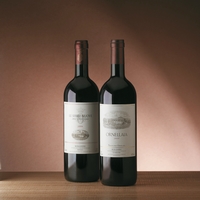Axel Heinz, winemaker for Ornellaia, was in Boston last week showing the newly released 2008 Ornellaia and its second wine, Le Serre Nuove, along with the 2006 and 2007 vintage of each. Whenever you’re around Heinz, you learn something, and not just about the wines he’s pouring.
Heinz epitomizes the new Europe. Born in Germany of a German father and a French mother, he spent summers in the Bordeaux region. His German school friends all vacationed in Tuscany and raved about those wines. Since his mother was from Arachon, a seaside  town near Bordeaux, he felt compelled to respond by learning about the wines of the area. On one trip back to visit his mother’s family he had a local wine merchant put together a case of Bordeaux to allow him to explore the various regions. He fell in love with the wines and now he’s in Tuscany making stellar wines from Bordeaux varieties.
town near Bordeaux, he felt compelled to respond by learning about the wines of the area. On one trip back to visit his mother’s family he had a local wine merchant put together a case of Bordeaux to allow him to explore the various regions. He fell in love with the wines and now he’s in Tuscany making stellar wines from Bordeaux varieties.
Despite his youngish demeanor (he’s only 40 years old), he has tremendous experience with Bordeaux grapes, especially Merlot, having been winemaker at La Dominique, a St. Emilion Grand Cru Classé, responsible for the 2001 – 2003 vintages there, before taking the reigns at Ornellaia. Though thoroughly knowledgeable about a broad range of wines, he’s not chauvinistic and conveys an honesty that makes many marketing-types worry.
Unlike Bordeaux first growths, Tenuta dell’Ornellaia is proud to show their second wine next to their first wine. Le Serre Nuove comprises about 25% of the production, is made from younger vines, and like Ornellaia is a blend of Cabernet Sauvignon, Cabernet Franc and Merlot, with Merlot comprising more of the blend. (Neighboring Sassicaia is a blend of the two Cabernets). As with all second wines, Le Serre Nuove evolves more quickly and is ready to drink sooner. The major difference between Le Serre Nuove and Ornellaia, in each vintage poured, was mostly textural, not one of power. Ornellaia was far more complex and layered–not “bigger”–and much more polished and seamless. Not that Le Serre Nuove was coarse. Its “coarseness” was only apparent next to the highly polished Ornellaia. It’s like feeling the difference between a $3,000 Italian suit and a $1,000 one. At about one-third the price, Le Serre Nuove, represents fine value.
The growing conditions during the three vintages, which Heinz describes as a “great trio,” were very different and reflected in the wines.
The very dry 2006 produced small concentrated berries and concentrated wines that are structured and tightly wound at this stage. The Ornellaia, which has potential to ultimately be one of their best, has closed considerably since last year. Even Le Serre Nuove would benefit from another year or two in the bottle.
The summer of 2007 was hot, but then cooler during harvest. Both Ornellaia and Le Serre Nuove had evolved beautifully from last year and were showing extraordinary power and grace.
2008 was a vintage “of extremes,” according to Heinz, with a rainy spring, hot summer and a harvest that occurred during two weeks of extreme heat followed by two weeks of cooler weather. The wines are concentrated, dense and almost chewy, with chocolate-like elements, but still fresh and vibrant thanks to that characteristic Tuscan acidity. They need time. Even the more approachable Le Serre Nuove needs another year or two in the bottle. Heinz believes the 2008 Ornellaia will be a “worthy successor to the 2006 and 2007.”
Heinz explained new regulations for the Bolgheri DOC for the 2011 vintage. Whether they will apply retroactively to wines already made, but not yet labeled, is not clear. Previously, rules required wines to be a blend with no one grape comprising more than 70%, which created, as only the Italian bureaucrats can, the paradox–again–that the highest quality wine, Massetto, could not carry DOC status because it was made exclusively from Merlot. Now wines can be made exclusively from Cabernet Sauvignon, Cabernet Franc or Merlot. Other grapes, such as Sangiovese, Petit Verdot or Syrah, can be included but can account for no more than 30 percent of the blend. Will Massetto now carry the DOC Bolgheri designation? Heinz favors using the DOC, but admits they are unsure, adding, “Massetto is Massetto.”
2
